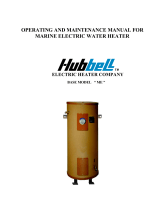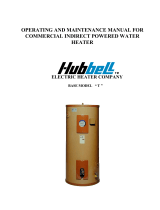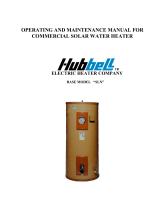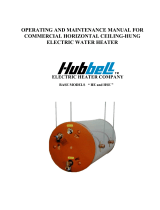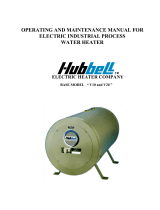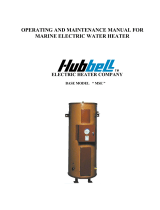Page is loading ...

OPERATING AND MAINTENANCE MANUAL FOR
COMMERCIAL ELECTRIC WATER HEATER
ELECTRIC HEATER COMPANY
BASE MODEL “ E ”

2
HUBBELL
ELECTRIC HEATER COMPANY
P.O. BOX 288
STRATFORD, CT 06615
PHONE: (203) 378-2659
FAX: (203) 378-3593
INTERNET: http://www.hubbellheaters.com/
-- IMPORTANT --
Always reference the full model number and serial number when calling the factory.
WARNING / CAUTION
1. Tank is to be completely filled with water and all air is to be vented before energizing.
2. Due to the rigors of transportation, all connections should be checked for tightness before heater
is placed in operation.
3. Safety relief valve must be installed in tapping provided.
4. The refractory material used in heating elements may absorb some moisture during transit,
periods of storage, or when subjected to a humid environment. This moisture absorption results
in a cold insulation resistance of less than twenty (20) megohms. If this heater has been
subjected to the above condition, each heating element must be checked for insulation
resistance before energizing. A low megohm condition can be corrected by removing the
terminal hardware and baking the element in an oven at 350°F -700°F for several hours or until
the proper megohm reading is obtained.
5. KEEP AWAY FROM LIVE ELECTRICAL CIRCUITS.
Do not perform any maintenance, make any adjustments, or replace any components inside the
control panel with the high voltage power supply turned on. Under certain circumstances,
dangerous potentials may exist even when the power supply is off. To avoid casualties, always
turn the power supply safety switch to off, turn the charge or ground the circuit before
performing any maintenance or adjustment procedure.
6. The unit is designed to operate at pressure not more than 150 psi.
7. Generalized instructions and procedures cannot anticipate all situations. For this reason, only
qualified installers should perform the installations. A qualified installer is a person who has
licensed training and a working knowledge of the applicable codes regulation, tools, equipment,
and methods necessary for safe installation of an electric resistance water heater. If questions
regarding installation arise, check your local plumbing and electrical inspectors for proper
procedures and codes. If you cannot obtain the required information, contact the company.

3
TABLE OF CONTENTS
SECTION TITLE PAGE #
I GENERAL DESCRIPTION AND CONSTRUCTION 5
II INSTALLATION 8
III SCHEDULED MAINTENANCE AND OPERATION 10
IV TROUBLESHOOTING 12
V SERVICING & REPLACEMENT OF PARTS 13
VI MISCELLANEOUS CHARTS AND FORMULAS 21

4

5
SECTION I - GENERAL DESCRIPTION AND CONSTRUCTION
GENERAL DESCRIPTION
This book describes a packaged electric water heater that is a stationary, self-contained unit. The
complete assembly consists of the storage tank, immersion electric heating element(s), thermostat(s),
safety relief valve, safety high temperature cut out, and any other required electrical operating control.
Optional equipment may be supplied with your unit. Please consult the product drawing for details
specific to your assembly. The unit is factory assembled, insulated, jacketed, wired, tested, and ready
for electrical and plumbing service connections.
CONSTRUCTION
TANK
Standard Tank Construction:
The standard storage tank is constructed of steel and internally lined with specially formulated
Hydrastone cement to a ½-inch minimum thickness. The tank is designed for a maximum allowable
working pressure of 150 psi (300 psi TP).
Optional Tank Construction:
Optionally, the storage tank may be constructed of all welded solid copper-silicon alloy (ASTM B-96)
or type 316L stainless steel for maximum tank longevity. No internal lining is required due to the non-
ferrous materials used in the construction of the pressure vessel. The tank is designed for a maximum
allowable working pressure of 150 psi (300psi TP).
TANK CONNECTIONS
The heater is supplied with separate cold water and hot water connections. Water entering the cold
water inlet is deflected by means of a baffle within the tank. The hot water outlet includes a built in heat
trap to prevent hot water from radiating out from the heater. A ¾-inch FNPT connection is located on
the side of the heater for mounting a combination safety temperature and pressure relief valve. An
overflow line should be utilized from the relief valve outlet to a floor drain. A ¾-inch GHT connection
is supplied for draining. See drawing for locations and sizes.
HEATING ELEMENT
The water heater is supplied with an electric immersion heating element assembly(s), composed of a
copper sheathed element(s) that are brazed into a brass flange. Each assembly is fastened to a
corresponding tank flange using a gasket and four (4) 3/8-16 x 1-inch long hex head steel bolts and
nuts. See drawing for voltage and power ratings.

6
CONTROL THERMOSTAT
The water heater is supplied as standard with a surface mounted thermostatic switch that is installed
and wired at the factory. As an option an immersion thermostat is available. See drawing for specific
details. The surface mounted thermostat can be adjusted through a range of 110° - 170° F. The
immersion thermostat can be adjusted through a range of 100° - 190° F. Both thermostats are adjustable
with a flat tip screwdriver.
Surface Mounted Thermostat
(Standard)
Immersion Thermostat
(Optional)
TEMPERATURE HIGH LIMIT SWITCH
As a safety device, a surface mounted high temperature cut-off switch with manual reset, factory set at
190° F, is supplied. As an optional, an immersion high temperature cut-off switch with manual reset,
factory set at 180° F, may be provided. In the event of an over-temperature condition, the thermostat
will disengage the power from the system. The high limit must be manually reset thereafter to restart
the heater.
Manual Reset
Immersion High Temperature Cut-Off Switch
(Optional)
Surface Mounted High
Temperature Cut-Off Switch
(Standard)

7
OUTER SHELL AND INSULATION
The tank is encapsulated in 2-inch thick polyurethane foam insulation. The insulation is protected by a
high impact non-corroding colorized composite protective jacket.
OPTIONS
The following optional features may be included in your water heater. Reference included drawing
specific to your heater for further details.
Low Water Cut-Off
Used as a safety device, the electronic low water cut-off is used to detect a low water situation and
disengage the operating coils in the magnetic contactor(s). Once the condition is remedied, the low
water cut-off switch is automatically reset.
Dial Temperature and Pressure Gauge
A combination temperature (70° - 250° F) and pressure (0 – 200 psi) gauge with 2½-inch dial may be
supplied for in-line installation (shipped loose) or factory installed in the tank.
Vacuum Relief Valve
A vacuum relief valve may be provided with the unit to reduce the risk of back siphonage and back
pressure of the system. The valve will be shipped loose for in-line installation. Instructions for
installation are provided with the valve.
Horizontal Constructions
The unit can be designed for horizontal installation, either ceiling hung or base mounted.
Building Management System (BMS)
A Building Management System control package may be supplied for remote operation and alarm
capabilities.
Electro-Mechanical Timer
An electro-mechanical 7-day time clock with battery back-up may be supplied for specific timing
operations. A set of instructions will be supplied with the timer.

8
SECTION II – INSTALLATION
WARNING / CAUTION
DO NOT TURN ON THE ELECTRIC POWER SUPPLY to this equipment until heater is
completely filled with water and all air has been released. If the heater is NOT filled with water when
the power is turned on, the heating elements will burn out.
For protection against excessive pressures and temperatures, local codes require the installation of a
temperature-and-pressure (T&P) relief valve certified by a nationally recognized laboratory that
maintains periodic inspection of production of listed equipment of materials, as meeting the
requirements for Relief Valves and Automatic Gas Shutoff for Hot Water Supply Systems. ANSI
Z21.22-1971. THE CUSTOMER IS RESPONSIBLE TO PROTECT PROPERTY AND
PERSONNEL FROM HARM WHEN THE VALVE FUNCTIONS.
All water heaters have a risk of leakage at some unpredictable time. IT IS THE CUSTOMER'S
RESPONSIBILITY TO PROVIDE A CATCH PAN OR OTHER ADEQUATE MEANS, SO THAT
THE RESULTANT FLOW OF WATER WILL NOT DAMAGE FURNISHINGS OR PROPERTY.
WATER HEATER PLACEMENT
1. Place the heater on a solid foundation in a clean, dry location nearest to the point of most
frequent hot water use. If the heater is to be raised off the floor, the entire bottom of the
heater should be supported by a solid surface.
2. The water heater should be protected from freezing and waterlines insulated to reduce energy
and water waste.
3. Leave a minimum of 18” clearance for element withdrawal, if necessary.
4. Do not install in an area where flammable liquids or combustible vapors are present.
PIPING INSTALLATION
NOTE: The most effective means for preventing deterioration from accelerated corrosion due to
galvanic and stray current is the installation of dielectric fittings/unions. The installation of these
fittings is the responsibility of the installing contractor.
1. Connect the cold water inlet and hot water outlet to the appropriate connections as shown;
refer to the drawing for location and sizes.
2. Install in-line vacuum breaker and in-line pressure and temperature gauge, if supplied.
3. Install the combination temperature and pressure safety relief valve in the tapping provided.
Note that this is required by law for safety considerations.

9
Outlet to floor drain Install into provided tapping
Manual Release
Lever
Temperature Probe
Temperature and Pressure Relief Valve
4. Install a relief valve overflow pipe to a nearby floor drain. CAUTION: No valve of any type
should be installed between the relief valve and tank or in the drain line.
FILLING THE HEATER
1. Completely close the drain valve.
2. Open the highest hot water faucet to allow all air to escape from piping.
3. Open the valve to the cold water inlet and allow the heater and piping system to completely
fill, as indicated by a steady flow of water from the open faucet.
ELECTRICAL INSTALLATION
1. Enter junction box with properly sized feeder leads.
2. Connect these power leads to wires enclosed in junction box with wire nuts.
3. All other electrical connections are made at the factory; therefore, no other electrical
connections are necessary.
FINAL CHECKS
1. Check all connections for tightness.
2. Ensure that all the above steps are completed
3. After the water is heated for the first time, monitor the water temperature as described in
Section III, Quarterly Inspection.

10
SECTION III - SCHEDULED MAINTENANCE AND OPERATION
WARNING / CAUTION
Before performing any maintenance procedure, make certain power supply is OFF and cannot
accidentally be turned on.
MAINTENANCE AND OPERATION
The water heater is automatic in its operation. It will maintain a full tank of water at the temperature
setting of the thermostat. The water heater should not be turned on without first making sure that the
tank is full of water and that all air has been released.
FREEZING
The tank should be fully drained in the event the electricity has been turned off and if there is danger
of freezing.
QUARTERLY INSPECTION
1. Monitor thermostat
a. Let water heater completely heat to a designated thermostat setting.
b. After thermostat satisfies (that is, when the thermostat actually clicks off), draw water from
heater.
c. Compare water temperature of drawn water to the temperature setting of the thermostat when
it satisfies. Normal variation between the two points is approximately + 5°F.
d. If these two readings do not coincide within acceptable tolerances and verification has been
made of the accuracy of the temperature-reading gauge, replace the thermostat.
2. Lift test lever on relief valve and let water run through valve for a period of approximately 10
seconds. This will help flush away any sediment that might build up in water passageways.
3. Inspect element flange for leakage as follows:
a. Shut off Power Supply.
b. Remove element housing cover.
c. Visually inspect heating element gasket for evidence of leaks.
d. Rub finger around gasket that is between the heating element and tank flange for any
evidence of moisture. If moisture is present or a water drip is observed, follow procedure
outlined in Section V.
4. Check for loose electrical connections. Tighten as necessary.

11
ANNUAL INSPECTION
1. Flush tank as follows
a. Shut off power supply.
b. Close valve on hot water outlet piping.
c. Open valve on drain piping.
d. Cold water inlet line pressure will be strong enough to flush sediment from the bottom of the
tank out through the drain. Let water run for 3-4 minutes.
e. Close drain valve.
f. Open hot water valve.
g. Turn power supply ON.

12
SECTION IV – TROUBLESHOOTING
Symptom Probable Cause Corrective Action / Remedy
Circuit breaker tripped at source. Reset circuit breaker.
High limit switch tripped. Reset high limit switch.
Loose wires. Tighten wires. Torque screws per torque
chart included in Section VI.
Heating element inoperable. Check heating element operation by
clamping an Amprobe around each wire to
the element. The ampere reading should
agree with the nameplate ‘AMP’ figure.
Low line voltage. Have source electrical system checked by
an electrician.
Faulty thermostat. Move thermostat dial through full range. A
definite ‘click’ should be heard. If not,
replace thermostat.
No hot water
Faulty low water cut-off, if
installed.
Check to see if tank is full of water. If not,
fill tank. If problem continues and tank is
full, check for continuity between the
common and normally open contact of the
relay board. If continuity is not observed,
replace low water cut-off.
Faulty thermostat. Check thermostat adjustment. Monitor
thermostat as described in Section III,
Quarterly Inspection. Replace if necessary.
Heating element not working on
all phases
Check to see that heating element is
working on all phases, by checking the
resistance (ohms) value for each element
and comparing with the chart included in
Section VI.
Water temperature
below settings at all
times
Heater improperly sized Verify heater is properly sized for the flow
rate and temperature rise of your system.
See formulas included in Section VI.
Replace elements with proper size as
necessary.
Relief valve
discharges
continuously
Excessive temperature or
pressure in tank
Temperature and pressure relief valves are
made to operate if the water temperature
exceeds 210°F or water pressure exceeds
the pressure rating of the safety relief valve.
If trouble is excessive temperature, then
thermostat is not shutting off at the right
setting and thermostat must be replaced.

13
SECTION V - SERVICING & REPLACEMENT OF PARTS
WARNING / CAUTION
Before servicing or replacing any part make sure to turn the power supply switch to the OFF position.
SURFACE TEMPERATURE HIGH LIMIT CUT-OFF
1. Disconnect power from unit.
2. Remove access cover.
3. Disconnect the four (4) 14 gauge wires or three (3) 14 gauge wires and a jumper, as required.
Control Wires High-Limit Cut-Off Switch
Manual Reset Control Wires
Temperature Controller
4. Disconnect the high-limit cut-off switch from the temperature controller by pulling the cut-
off switch up and away from temperature controller.
5. Replace control and install new high limit switch by performing above steps in reverse order.

14
IMMERSION TEMPERATURE HIGH LIMIT CUT-OFF
1. Disconnect power from unit.
2. Remove access cover.
3. Remove high limit cover screw and cover.
Cover
Cover Screw
Reset Switch
4. Disconnect the two (2) 14 gauge wires.
Wires
Capillary Tube
5. Remove capillary tube and bulb from thermowell
6. Remove two (2) mounting screws.
Mounting Screws
7. Remove control and install new high limit switch by performing above steps in reverse order.
(Note: Be sure to place capillary tube into slot in base prior to installing cover.)

15
HEATING ELEMENT
1. Disconnect power from unit.
2. Shut off incoming water supply.
3. Attach hose to drain connection.
4. Lift manual release lever on relief valve to let air into system or break union on outgoing
water line.
5. Drain water from tank.
6. Disconnect the wires from the heating element terminals.
Tank Flange
Wires
7. Remove the 3/8-16 nuts.
8. Withdraw element assembly and remove gasket.
Gasket
Element Assembly
Nuts
9. Install new gasket and insert new heating element.
10. Rewire element according to type of unit as shown below.
11. Fill tank and check around gasket for any leaks.

16
2
L1 L2 L3
L1 L2
Single Element Operation
3 Ø Open Delta Wiring for Simultaneous Operation
4
1 3
2
1
1
2
1
2
3
4
1 3
4
2
1
2

17
L1 L2 L1 L2
Interlocked for Non-Simultaneous Operation Non-Interlocked for Simultaneous Operation
1
1
1
1
2
2
2
2
3 3
4 4
4 4
1 1
2 2

18
SURFACE MOUNTED THERMOSTAT
1. Disconnect power from unit.
2. Remove access cover and locate thermostat.
3. Disconnect the two (2) or three (3) 14 gauge wires and jumpers, as required.
Control Wires
4. Remove two (2) mounting screws and disconnect from high limit cut-off, if required.
Mounting Screws
5. Replace thermostat using the reverse procedure.

19
IMMERSION THERMOSTAT
1. Disconnect power from unit.
2. Remove access cover and locate thermostat.
3. Remove high limit cover screw and cover.
Cover
Cover Screw
4. Disconnect the two (2) or three (3)
14 gauge wires, as required.
Wires
Capillary Tube
5. Remove capillary tube and bulb from thermowell.
6. Remove two (2) mounting screws.
Mounting Screws
7. Replace thermostat using reverse procedure. (Note: Be sure to
place capillary tube into slot in base prior to installing cover.)

20
RELIEF VALVE
1. Disconnect power from unit.
2. Shut off incoming water supply.
3. Lift test lever on relief valve to relieve pressure in tank.
4. Disconnect overflow piping.
5. Unscrew relief valve, remove assembly and replace with new one.
6. Connect overflow piping.
7. Turn on incoming water supply and check for leaks.
8. Turn safety switch to ON position.
Test Lever
Overflow Piping Outlet
Tank Connection
Temperature Probe
1/23
